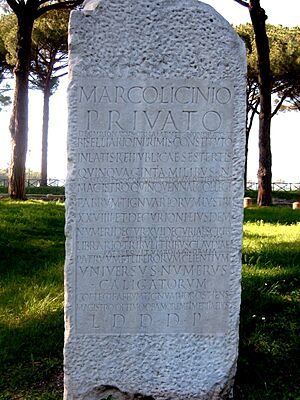Collegium (ancient Rome) facts for kids

In ancient Rome, a collegium (plural: collegia) was like a club or an association. These groups acted as a single unit, similar to how a company or organization works today. They could be for everyday people or for religious purposes.
The word collegium comes from the Latin word for "society" or "colleague." Members of a collegium worked together for shared interests. These interests covered many parts of Roman life, such as politics, religious practices, different jobs, trade, and helping the community. Because members of collegia knew each other well, these groups became quite powerful. They could influence politics and the economy, acting like groups that speak up for traders and merchants.
Some collegia were involved in political fights and social problems. Because of this, the Roman government sometimes tried to stop these groups. After laws were passed by Julius Caesar (around 49–44 BC) and later by Augustus (around 27 BC–14 AD), collegia needed special permission from the Roman Senate or the Roman emperor to be officially recognized.
Everyday Roman Clubs
Collegia could work like guilds (groups for people with the same job), social clubs, or even groups that helped members pay for funerals. In ancient Rome, they sometimes became organized groups of local business people. Official collegia had certain rights, like owning property together, having a shared money fund, and being able to hire a lawyer.
Many people in Roman towns belonged to collegia. There were collegia for many parts of daily life. These groups were often set up like the Roman government itself, with the Roman Senate being the main example. Their meeting halls were often called a curia, just like the Senate's meeting place.
The Roman government closely watched the creation of collegia. After Julius Caesar's reforms (between 49 and 44 BC) and Augustus's updates, new collegia needed approval from the Roman Senate or the emperor to be legal. The government often suspected these groups and sometimes placed limits or even banned them.
The rules for everyday collegia changed often. In 64 BC, the Senate banned all civic collegia, saying they went against Roman law. But six years later, in 58 BC, they were allowed again. Julius Caesar's reforms broke up all but the oldest collegia. He made a rule that any new collegium had to be approved by the Senate as being useful to the community. Later, in the 2nd century AD, collegia seemed to have more freedom. Under Emperor Hadrian, records show that collegia in Asia Minor could operate with fewer and less strict Roman rules. However, Emperor Aurelian put collegia under state control in the late 3rd century.
Religious Groups
Religious collegia were groups of priests approved by the Roman government. They performed many religious duties in Rome. These duties included overseeing special ceremonies, practicing augury (predicting the future by watching birds), keeping religious texts, organizing festivals, and maintaining specific religious cults (worship of emperors or gods). Besides their religious roles, these collegia also helped members with funerals and provided a sense of community.
There were four very important religious collegia of Roman priests:
- The Pontifices (the College of Pontiffs), led by the pontifex maximus (the chief priest).
- The Augures, who practiced augury.
- The Quindecimviri sacris faciundis, who looked after sacred books.
- The Septemviri epulonum, who organized religious feasts.
Other smaller religious collegia included:
- The Fetiales
- The Salii
- The Titii
- The Fratres Arvales
- The Luperci
- The Sodales Augustales
Military Clubs
During the Roman Republic and around 100 AD, military collegia were sometimes seen as small, violent groups. Later, during the time of Emperor Septimius Severus (193–211 AD), military clubs became more common. Records from Lambaesis show that these clubs were formed by lower-ranking officers and specialists in the army. During the Severan dynasty (193–235 AD), the government focused on improving the lives of soldiers. The main goal of military collegia was to help members pay for funeral costs. Officers and special personnel could join these clubs, but regular soldiers on active duty usually could not. Being a member of a military collegium gave an officer some financial protection for unexpected costs.
Where They Were Found
Old inscriptions show that collegia existed in 84 Roman cities, including Rome. Most collegia were found in Italy, Pannonia (parts of modern-day Hungary, Austria, etc.), and Southern Gaul (modern-day France). They were less common in other Roman provinces.

